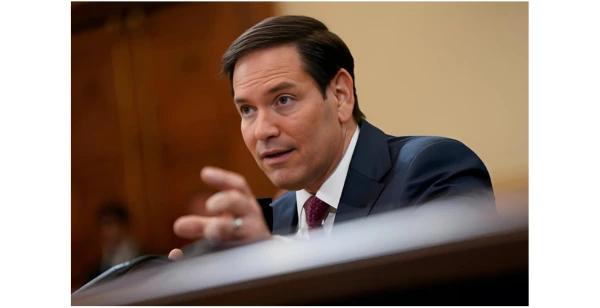After May’s Crisis, U.S. Signals Vigilance: Why Secretary Rubio Says America Watches India–Pakistan Truce “Every Single Day”
Introduction
The relationship between India and Pakistan has long been one of the world’s most delicate balancing acts. Both nations share a complicated history, marked by wars, border clashes, and decades of mistrust—made even more dangerous by their nuclear capabilities. Against this backdrop, U.S. Secretary of State Marco Rubio recently revealed that Washington is closely monitoring developments in the region “every single day.”
His words, delivered in an interview with NBC News, come just months after the May 2025 conflict, which brought South Asia to the edge of a serious escalation. Rubio’s reminder serves as both a warning and an assurance: while the United States cannot dictate peace, it remains committed to keeping the fragile truce alive.
Why the U.S. Watches South Asia So Closely
For Washington, the India–Pakistan equation is more than a regional dispute—it is a potential global flashpoint. Even a small border skirmish can quickly spiral into something much larger, drawing in allies and disrupting international stability.
Rubio underlined this reality when he explained that brokering peace is not the hardest part—keeping it intact is. Ceasefire deals, as history has shown, are often temporary and vulnerable to collapse. This is why American diplomats and intelligence agencies keep track of developments day by day, hour by hour.
Beyond security, the U.S. has multiple interests at stake: safeguarding global trade routes, countering terrorism, and ensuring that South Asia’s nuclear powers do not stumble into a confrontation that would have far-reaching consequences.
The May 2025 Escalation: How It Began
The crisis erupted when 26 Indian tourists were killed in a militant attack in Kashmir. The tragedy triggered a strong response from New Delhi, which launched targeted missile strikes on suspected militant camps across the border.
Pakistan retaliated militarily, raising fears of uncontrolled escalation. Within days, international concern surged, with capitals across the globe urging restraint. For a moment, the specter of a nuclear confrontation loomed large—reminding the world how dangerous this rivalry remains.
Behind the scenes, U.S. officials scrambled to prevent further escalation. Secretary Rubio, along with Vice President JD Vance, engaged in intense shuttle diplomacy. By May 10, 2025, the Director Generals of Military Operations (DGMOs) from both countries confirmed a ceasefire agreement—bringing an abrupt halt to the hostilities.
Two Narratives, One Ceasefire
Although the guns fell silent, the political messaging that followed revealed just how differently the two countries saw the truce:
-
Pakistan’s stance: Islamabad openly credited the United States and even former President Donald Trump, praising their intervention as decisive in preventing escalation.
-
India’s stance: New Delhi firmly rejected suggestions of outside mediation, insisting that the ceasefire was a result of its own strategic and diplomatic handling.
These clashing narratives reflect not only the fragility of peace agreements but also how deeply national pride shapes political storytelling in South Asia.
Why Rubio’s “Every Single Day” Statement Matters
Rubio’s remark is more than diplomatic rhetoric. It sends three important signals:
-
Acknowledgment of Risk: South Asia remains one of the world’s most volatile nuclear flashpoints, requiring constant vigilance.
-
Preventive Diplomacy: Daily monitoring allows Washington to act quickly, reducing the risk of miscalculation before it snowballs into conflict.
-
Message to Both Capitals: India and Pakistan are reminded that their actions are not happening in isolation—the world is watching.
At the same time, Rubio’s comments echo Donald Trump’s repeated claims of having averted nuclear escalation in the past, though India has consistently downplayed this version of events.
The Larger Implications for Peace in South Asia
The May 2025 crisis highlights a hard truth: peace between India and Pakistan is always fragile. While ceasefires can stop the fighting, they cannot erase decades of mistrust, territorial disputes, or cross-border militancy.
Long-term stability will require more than military restraint. It demands political will, mutual trust, and sustained dialogue—elements that have often proven elusive. The U.S., by monitoring and engaging diplomatically, plays the role of a silent stabilizer, but it cannot enforce reconciliation.
For ordinary citizens on both sides of the border, what’s at stake is more than politics or strategy—it is the hope of living without fear of sudden violence.
Conclusion
Secretary Marco Rubio’s words—that America tracks the India–Pakistan situation “every single day”—highlight both the urgency of the moment and the fragility of peace. The May 2025 crisis showed how quickly tensions can flare and how vital timely diplomacy is in preventing disaster.
Ultimately, however, the responsibility for lasting peace rests with New Delhi and Islamabad. External actors like the U.S. can encourage and mediate, but only the two neighbors can transform a ceasefire into a foundation for genuine stability. History has shown that calling a truce is easy; the true test is sustaining it.














